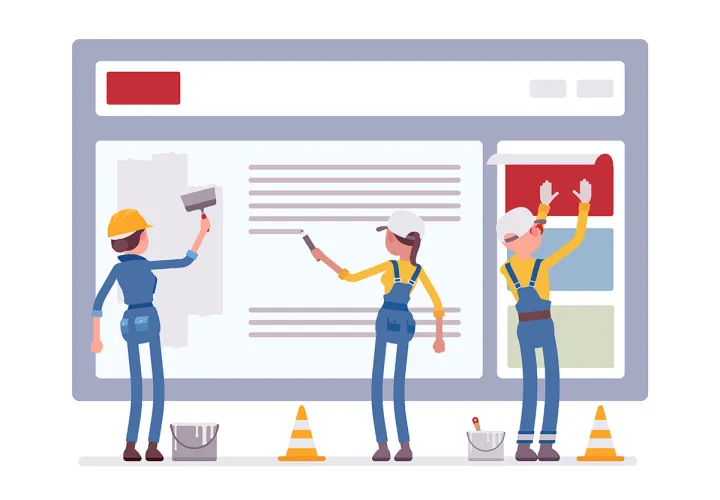
Starting an affiliate website is a great way to earn passive income by promoting products or services. However, creating an affiliate website may seem like a huge and overwhelming task to at first. Don’t worry! This tutorial will guide you through the most important steps you need to take in order to start and create an affiliate website, from initial planning to launching and improving your affiliate website. By simply following the steps in this tutorial, you’ll be well on your way to creating a successful affiliate website.
Step 1: Choose a Niche
The very first step when starting an affiliate website is to choose a niche. A niche is a specific part of the market you will focus on. Your niche determines your target audience, the type of content you’ll create, and the products or services you’ll promote. Below we summarize the most important factors to consider when choosing a niche. If you would like more detailed guidance or explanation on choosing a niche, visit our article on How to Choose a Niche for Affiliate Marketing.
- Your interests and expertise: Choose a niche that you are passionate about and knowledgeable in. This will keep you motivated through the process of creating your affiliate website. Additionally, your enthusiasm and knowledge will shine through in your content, making your recommendations more valuable.
- Market demand and competition: Research market trends and consumer interests. Tools like Google Trends, and other keyword research tools, can help you estimate how much interest there is in your topic. Also, analyze the competition in your potential niche. Ultimately, you’ll want to find a niche with high demand and relatively low competition. For your first affiliate website, don’t go for highly competitive niches.
- Affiliate programs: Make sure that there are affiliate programs available in your niche. We set up a database of affiliate programs where you can check out the affiliate programs and their commission in your chosen niche.
Once you’ve chosen your niche, it’s time to move on to the next step.
Step 2: Choose a Domain Name and Web Hosting
The next step is to choose a domain name and web hosting for your affiliate website. Your domain name is your website’s address, while web hosting is where your website’s files will be stored.
Tips for Choosing a Domain Name
Your domain name is your website’s identity on the web. It should be memorable, relevant, and SEO-friendly.
- Relevance: The domain should be relevant to your niche. For example, if your niche is fitness—a niche which is too broad for your first affiliate website—you should consider words like “fit”, “health”, “training”, or “workout”.
- Memorability: Choose a name that is easy to remember and spell. Shorter names are easier to remember and type. Aim for a name that’s no more than two or three words.
- SEO-friendly: Incorporating a relevant keyword in the domain name of your affiliate website can improve search engine ranking. However, there are clues that Google penalizes domains existing of an exact match on popular keyword phrases, so don’t overdo this.
- Availability: Check if the domain is available. You can check this with the hosting provider you want to use. If possible choose a popular extension like .com or the extension specific to the country you’re in. Unpopular extensions tend to receive less clicks when shown to users in, for example, the search results.
Tips for Selecting the Right Hosting Provider
Selecting a good hosting provider is important for your affiliate website’s performance, security, and scalability. Your hosting provider will store the files of your website and make your site accessible to users. Below we’ve listed the most important factors to consider:
- Uptime: Ensure the hosting provider guarantees at least 99.9% uptime. Seems unreasonable? This target is met even if your website is down for 40 minutes a month.
- Customer support: If there is an issue with the hosting of your website, you want it to be resolved quickly. 24/7 customer support is a good thing, but also be sure to check the reviews of the provider to see if their support is helpful.
- Storage: Many of the low budget shared hosting plans have limited storage available. If you’re not planning to use many/large images or videos, 5GB is probably fine.
- Traffic: Some providers limit the allowed traffic from their hosting. Make sure this is enough and keep an eye on it. You don’t want your website to be put offline when it is generating lots of traffic.
- Costs: You want to keep the costs of your website as low as possible, also in the long term. Keep in mind that many hosting providers offer huge discounts for the first year. After the first year, they may be a tenfold of the first year. Hosting providers use this tactic because most people don’t want to move their website from one hosting to another after the year has expired.
- Scalability: Most hosting providers don’t mind if you want to upgrade your plan before your contract expires. It can be smart to check this with your provider and to look ahead to the cost of the larger plans so you can upgrade when necessary.
For more information and recommendations, check out our article on How to Select a Good Hosting Provider For Your Affiliate Website.
Step 3: Set Up Your Website

Once you’ve purchased your domain name and web hosting, it’s time to set up and create the essentials of affiliate website. Most affiliate marketers use WordPress, because its flexibility and extensive plugin library. However, you can alternatively use any other CMS or build you own.
The main steps to take to develop your website are:
- Choose a CMS or build your own: WordPress is highly recommended for its ease of use, community size and flexibility.
- Select a Theme: WordPress has hundreds of themes to choose from. Choose one and remember that you can always change at a later point.
- Install Essential Plugins: After installation you should install the essential plugins every website needs. Example are Yoast SEO for optimization, WPForms for contact forms, Complianz for cookie consent, LinkGenius for managing affiliate links and Google Site Kit for analysing visitor behavior.
- Create Essential Pages: Essential pages are the pages that should be present on every website. Examples are a Home page, Contact page, Privacy Page, and other pages required by law. When you run the wizard of the Complianz plugin, most of the mandatory pages by law are generated for you.
Most hosting providers we recommend have an one-click install option to install WordPress. You can then log in to the dashboard and customize your website’s appearance using a WordPress theme. For detailed instructions, refer to our tutorial on How to Set Up an Affiliate Website Using WordPress.
Step 4: Create Your First High-Quality Content

The key to a successful affiliate website is high-quality content. Create blog posts, articles, product reviews and other content that’s informative, engaging, and relevant to your niche.
Make sure your content is appealing to your target audience, you can do this by including images and videos. Also, make sure you apply on-page SEO, meaning that your articles have a clear subject, and have titles, headings and meta descriptions that reflect that subject. At this point you do not need to create much content, just enough for the affiliate networks and advertisers to see what your new site is about and how they will be promoted.
Step 5: Join Affiliate Programs
After you’ve created the base of your affiliate website, it’s time to join affiliate programs. This is the step where you set up how you will monetize your new affiliate website.
Make sure you choose programs that offer products or services that align with your niche. Also check the commission rate and other terms of the affiliate program at different affiliate networks, since they might differ. Our database of affiliate programs per country offers all the information you need to analyze and choose the best suited affiliate programs.
Step 6: Promote Your Affiliate Links
Once you’ve joined affiliate programs, it’s time to promote your affiliate links. Adjust your existing content so that they contain the affiliate links. Also create new content containing your affiliate links. Not all pages need to have affiliate links, you can also create pages to attract visitors and direct them to other content containing affiliate links.
This is where LinkGenius comes in handy. This WordPress plugin allows you to manage your affiliate programs at one place so that you can easily find or replace your affiliate links when, for example, a program quits. Also, it allows you to brand your links, add an affiliate disclosure or automatically apply the right relation attributes. The paid version offers more advanced features like automatic link placement based on keywords, tracking what commission your links generate and much more.
Step 7: Continuously Improve and Grow Your Affiliate Website

Finally, it’s important to continuously improve and grow your website. Analyze your website’s traffic and engagement metrics to see what’s working and what’s not. Regularly add new content to cover more topics within your niche and apply the things that work. Also, try new strategies from time to time, and experiment with different types of content and promotion methods.
Engage with your audience through comments, social media, and email. Find the communities where your target audience resides and engage with them as well.
As you grow your website, you may want to consider outsourcing some tasks like content creation or social media management. This can help you focus on the bigger picture and scale your website more efficiently.
Conclusion
Starting an affiliate website may seem overwhelming at first. But, by following the steps outlined in this guide, you can set up a successful affiliate website and start earning income through affiliate marketing.
Remember to choose a niche that you’re passionate about, create high-quality content, join relevant affiliate programs, and promote your affiliate links in a transparent and ethical manner. This article contains the most important steps in starting an affiliate website, for a more extensive version you can download our affiliate website checklist for free here (no email address or other data required).
